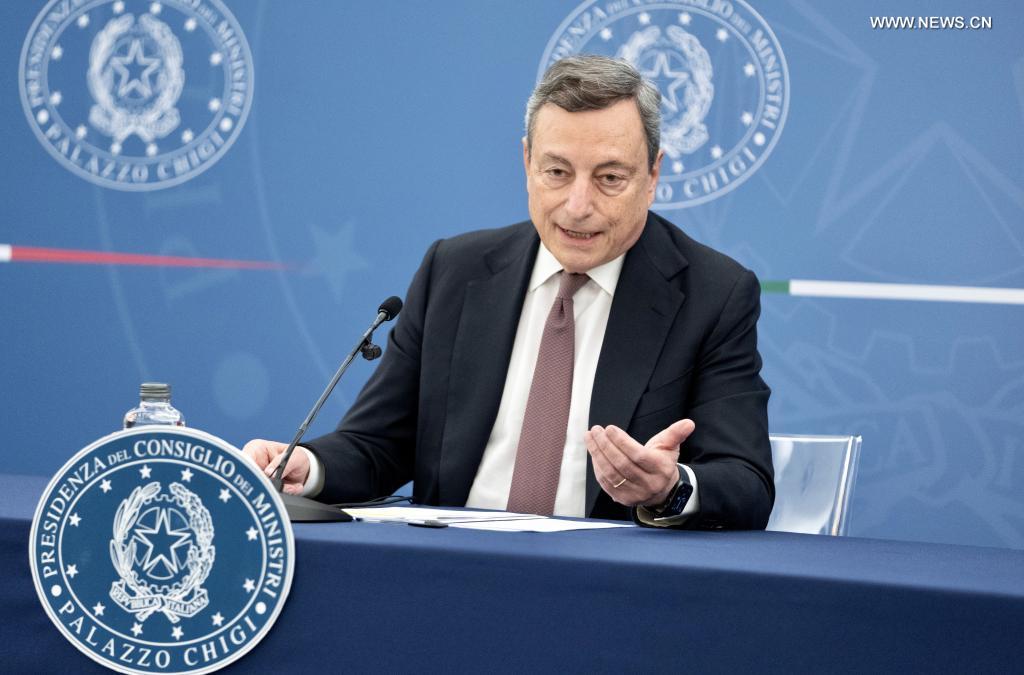
Italian Prime Minister Mario Draghi
ROME, July 23 (NNN-Xinhua) — The COVID Green Pass will be mandatory to enter restaurants, cafes and other eateries in Italy starting from Aug 6, the government announced.
The decision came after Prime Minister Mario Draghi’s cabinet reviewed the key anti-pandemic rules late on Thursday, strengthening some of them in an effort to stem a new surge of coronavirus infections mainly due to the Delta variant.
The green pass — a certificate containing proof that a person has received at least one dose of the vaccine, or is fully immunized — will be necessary for anyone older than 12 to eat in any venue indoor, but only when sitting at the tables.
It will also be required to enter live shows and concerts, sports events, museums and any other cultural facility, swimming pools and fitness centers, amusement and theme parks, betting shops and bingos, and to take part in public competitions.
In a joint press conference with Health Minister Roberto Speranza, Draghi explained that the cabinet’s goal was to act quickly so to avoid a major spike in new infections due to the virus variants, which would impact the economy.
“The Italian economy is recovering and the country is growing at a faster pace than other European countries,” Draghi said.
“Other European countries are already facing more infections compared to us (due to the Delta variant)… We have learned that, if we do not react swiftly, what seems distant can become a reality in a very short time.”
In the decree, the cabinet also changed the parameters at the base of the four-tier scheme that divides the 20 Italian regions into different colors — with different levels of restrictions — according to the assessment of their pandemic risk.
From July 23, the decision to move one region to a higher level of risk would be based on their rate of bed occupancy rather than the number of coronavirus cases at local level.
Any region would turn from white (no risk) to yellow (low risk) when exceeding 10 percent of bed occupancy in intensive care units and, at the same time, 15 percent of occupancy in normal COVID-19 wards.
Exceeding a bed occupancy of 20 percent and 30 percent, respectively, would make any region turn from yellow into orange (medium risk), and exceeding 30 percent (intensive care) and 40 percent (normal wards) into a red zone, signaling the highest pandemic risk and the toughest restrictions.
“We want to launch a positive signal, and avoid a new rise in the pandemic curve that would lead to new broad closures,” the health minister told reporters.
Vaccination is strongly recommended in Italy, but not mandatory. However, it is now required to work in any health care facility, and the cabinet is discussing whether this rule should apply to school staff.
So far, over 63 million vaccine doses were administered in Italy, and more than 28 million people were fully immunized after two jabs, according to government’s data. Some 40 million people have required the green pass after their vaccination, including people with the first dose.
The decree also extended the state of emergency to Dec 31, 2021. First declared on Jan 31, 2020, for six months, and already extended, the state of emergency allows the cabinet to act more swiftly in terms of anti-pandemic rules.
Up to July 22, Italy has registered about 4.3 million coronavirus cases. The total figure comprises over 54,000 active infections, 4.1 million recoveries, and 127,920 fatalities. — NNN-XINHUA





